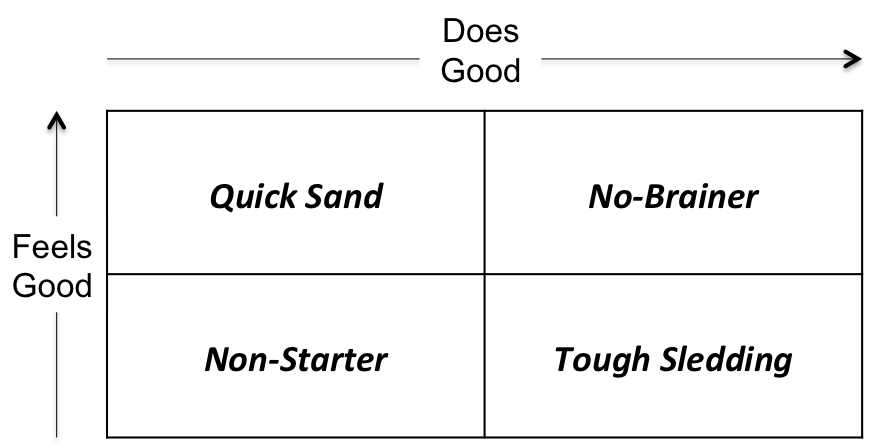There are things you can do that make a difference to your business and things that don’t. Worse still, there are things that feel like they make a difference but don’t. When you have a big problem to solve but are short on time or resources it’s essential to distinguish between high impact actions and feel-good busy work.
So let’s invent something we’ll call the Feel Good/Do Good Matrix to help sort things out. It looks like this:

“No-Brainer” actions (feel good and do good) and “Non-Starter” actions (don’t feel good and don’t do good) are pretty straightforward, although in desperate situations there may be panicked advocates for non-starter ideas. Most of our management energy is spent avoiding the “Quick Sand” while summoning the will to face the “Tough Sledding”.
Consider a business with a weak sales pipeline. What’s to be done to turn things around fast? Everyone could get on the phone and start making prospecting calls. Having all hands on deck would sure feel like positive action. But is this the best way to use technical or admin staff? Or management could set up daily sales meetings to review the status of every opportunity. However, unless they really contribute to closing those deals, daily meetings are just as likely to distract sales people as help them.
The allure of Quick Sand initiatives is that they are simple to start and, on the surface, appear promising. They are often reflexive management responses to issues. But to avoid squandering precious resources consider carefully whether these well-worn actions really work. Look at historical results to decide.
On the other hand, people are often reluctant to launch Tough Sledding initiatives, especially if there is any doubt about their success. They’re usually a lot of work (that’s why they don’t feel good). Convincing arguments to justify the effectiveness of the actions (along with some inspirational leadership) may be needed to overcome resistance.
It’s a constant battle for a management team to remain objective, particularly when the pressure is on. Using the Feel Good/Do Good matrix can help clarify many decisions, from setting daily priorities to responding to full-blown business crises. It’s a no-brainer way to sort out the best next steps – while avoiding stepping in quick sand!
This article was published more than 1 year ago. Some information may no longer be current.
